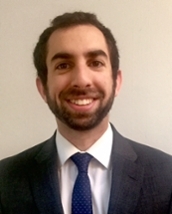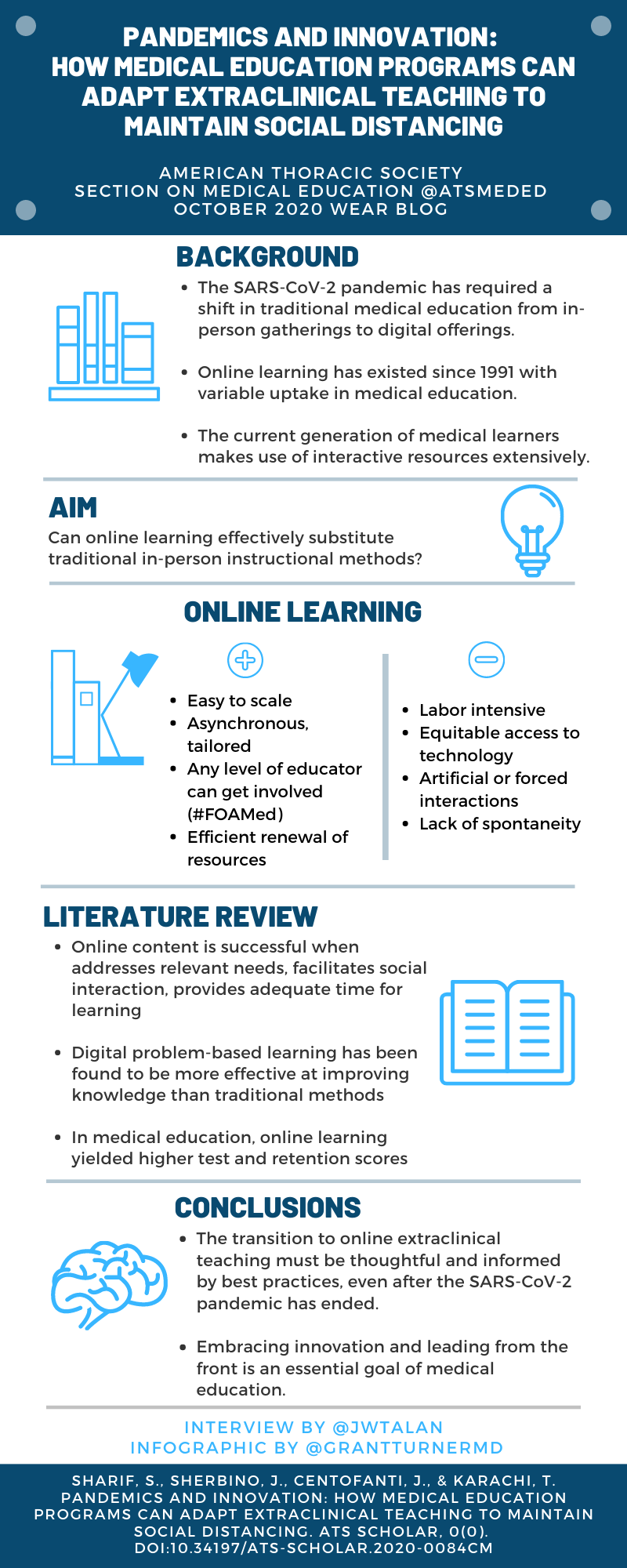Article:
Sharif, S., Sherbino, J., Centofanti, J. and Karachi, T: Pandemics and Innovation: How Medical Education Programs Can Adapt Extraclinical Teaching to Maintain Social Distancing. ATS Scholar 2020.
Summary:
As the SARS-CoV-2 pandemic spreads across the globe, medical education programs must utilize online learning to adapt to social distancing precautions. The authors of this article review some of the advantages and challenges in effective implementation of online extraclinical teaching. Online learning presents the opportunity to expand scale, provide asynchronous and tailored learning, and broaden the input of teaching voices. However, effective use requires a firm grounding in educational theory and attention to the online interaction between teacher and learner. For this blog post Jordan Talan, MD interviewed the first author Sameer Sharif, MD.
Interview:
JT: What inspired you to write about this topic? Did you face any particular challenges in your educational program that come to mind?
SS: The inspiration for this topic came from some of the hesitancy I encountered amongst our faculty/residents/fellows with respect to moving our curriculum online. As an authorship group, we felt that illustrating the well-established theories that support the use of learning online would clear up any doubts faculty/residents/fellows may have moving forward.
Adapting the hands-on skills for our program was a challenge. We had to cancel one of our point-of-care ultrasound (POCUS) workshops with standardized patients that I had organized with various stakeholders (i.e. US companies etc.). We were able to substitute this with a POCUS visual simulation seminar/conference via ZOOM (case-based: question/answer) which was effective for image interpretation but not fully for the acquisition part of things; thankfully, our simulation center is up and running again and we will be rescheduling this session. This highlights one of the limitations of online learning.
JT: Would you be willing to share some specific examples of the online learning within your program? Have you utilized journal clubs, simulation, presentations, grand rounds?
SS: Our Critical Care journal clubs are now online; in fact, they are some of the most well attended journal clubs by our faculty now. Our academic half-days/conferences are all online and these are also well attended (partly because of the increased flexibility learners have with not having to drive between multiple sites). In our Emergency Medicine program, Dr. Jonathan Sherbino was able to connect with Washington University to have a combined journal club online which was extremely valuable for our faculty and trainees. Simulation training has been moved to the online forum for our Emergency Medicine training program; this is in its infancy but is working well in conjunction with our Center for Simulation Based Learning. Our learners and instructors are all on a ZOOM call with a video link into the simulation room. The simulation center technicians perform the actions upon direction of the residents who are participating via ZOOM and then communicate their findings/results. Now that our academic half-days/conferences are online, there has been some talk about widening it to a greater audience (i.e. community physicians interested in maintaining their knowledge). However, this is being reviewed by the Residency-Education Committee as there are a number of issues that need to be discussed (i.e. safe space for learners to ask questions/engage with the material; the primary purpose of the conferences is residency education and not continuing professional development, etc). Grand Rounds are also now online and the attendance has also significantly increased.
JT: As you mentioned, there are some advantages to online learning. For example, the fellow attendance at many of our conferences has increased during COVID as fellows at different hospital sites can now easily come together online. What are some of the other ways that we can take advantage of online learning? What aspects of online learning do you think should persist after things “return to normal”?
SS: Depending on how the curriculum is designed, using online learning asynchronously can allow individuals to tailor their learning for their own individual needs. The pace can be up to each individual learner. One key advantage for me was the ability to get speakers from different institutions with more ease. It is often challenging for faculty from other institutions to commute to give a seminar. We were able to recruit a number of great speakers from hundreds of miles away to teach our trainees. Moreover, the democratization of teaching voices via online learning allows faculty from non-traditional institutions to contribute with ease as well. I truly believe that now is an excellent time for academic programs to reach out to other institutions and create a community of practice. Sharing resources and ideas in a collaborative informal network will tremendously aid knowledge-building. With respect to what aspects of online learning should remain: Recruiting speakers from different institutions is always a wonderful idea. Now that we have easy to access platforms to do this, I feel as though it would be advantageous to continue this practice. Furthermore, engaging with other institutions and training programs with shared journal clubs, grand rounds etc. is an excellent way to start and maintain a broader community of practice.
JT: Although it is perhaps less labor intensive to simply transfer existing educational formats to the online environment, this may not always produce the best results. What challenges have you encountered in adapting existing content for online use? In what ways can content be optimized for the online environment?
SS: As your question suggests, moving curriculum to an online format will not fix its underlying design problems or inattention to education theory. The focus needs to be on social learning. Learning needs to be interactive and requires learner engagement with each other, the material, and with experts. One of the challenges I've encountered is learner apathy with teaching material that is online. To address learner engagement issues on online platforms, I ask that all cameras remain on for the duration of the teaching session. I've also had success using online quizzes, such as PollEV. Furthermore, asking targeted questions to specific learners also assists with engagement. Moreover, I often create pre-conference assignments/questions to complete which we discuss as a group during our sessions.

Blog post author
Dr. Talan is a pulmonary and critical care fellow and aspiring medical educator at NYU Langone Health. His research interests include simulation, procedural education, and critical care echocardiography.
Twitter: @jwtalan

Article author
Dr. Sharif is an Intensivist, Emergency Physician, Clinician Educator, and a Health Research Methodologist in-training at McMaster University in Canada. His research is focused on bridging the gap between the Emergency Department (ED) and the Intensive Care Unit (ICU). His current interests include mechanical ventilation and sedation practices in the ED and the ICU. His education portfolio consists of creating curriculums for ICU/ER trainees and being actively involved in knowledge-translation practices through podcasting.
Twitter: @SameerSharifMD




